A current trend in garden design is to create gardens that have a sense of place. In Marcus Beach our “place” is nestled in between a number of different natural habitats that hold a wide diversity of plants.
The easiest way to create a sense of place in a garden is to use plants that grow in the area. This page describes some of the many and varied local native plants that are suitable for gardens.
The thumbnails are grouped under categories for easy reference. When you find the category you want, scroll down until you find a plant to suit your needs. Click on the name of the plant in the thumbnail to go to the blog page that has details of the plant and photos to spark your imagination.
Many of the photographs come from Marcus Beach gardens.
Ground covers and climbers |
 Twining Guinea Flower, Hibbertia scandens Twining Guinea Flower, Hibbertia scandensTwining Guinea Flower is a weak-stemmed scrambler and climber with a bright yellow flower (5-7 cm) followed by a distinctive red fruit. The individual stems can grow from two to five metres in length. |
 Pig Face, Carpobrotus glaucescens Pig Face, Carpobrotus glaucescensPig Face is a hardy, sun loving, creeping succulent with stems to two metres that root at the nodes along the stem. The plant has bright deep pink daisy-like flowers blooming mainly from October to January, which is the main growing period. |
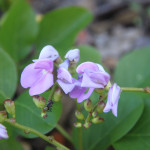 Coastal Jack Bean, Canavalia rosea Coastal Jack Bean, Canavalia roseaA large trailing or climbing vine found on sandy soils, Coastal Jack Bean has a pretty pink-purple pea-like flower followed by large, flattened seed pods. It has a distinctive compound leaf composed of three leaflets which makes it a particularly attractive addition to the garden. |
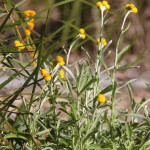 Yellow Buttons, Chrysocephalum apiculatum Yellow Buttons, Chrysocephalum apiculatumYellow Buttons, a pretty non-invasive ground cover with golden yellow flowers throughout the year, grows to 40 cm in height. It can spread to form a clump, but tends to stay small, and is not strong enough to smother more vigorous weeds. |
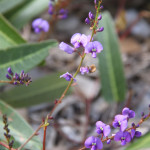 Native Sasparilla, Hardenbergia violacea Native Sasparilla, Hardenbergia violaceaNative Sarsaparilla is a common prostate or twining vine much loved for its purple pea flowers that bloom in winter and spring. It is an ideal ground cover for a sunny area of about one to two metres per plant. |
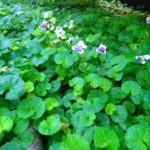 Native Violet, Viola banksii Native Violet, Viola banksiiNative Violet is an attractive fast growing groundcover that often forms dense mats. They have kidney shaped light green leaves & delicate purple and white edible flowers throughout the year. |
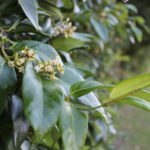 Monkey Rope Vine, Parsonsia straminea Monkey Rope Vine, Parsonsia stramineaParsonsia straminea is a vigorous woody vine that climbs by twining stems and adventitious roots. The attractive green leaves which are up to 24cm long, grow high up in the canopy. Small fragrant pale yellow tubular flower clusters are produced through spring, summer and autumn. |
Tufted plants |
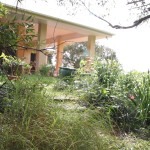 Kangaroo Grass, Themada triandra Kangaroo Grass, Themada triandraKangaroo Grass is ideal for coastal areas such as Marcus Beach because it likes acid soils with good drainage and will grow in sand as well as clay. It occurs naturally in the area. |
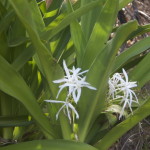 River Lily, Swamp Lily, Crinum pendunculatum River Lily, Swamp Lily, Crinum pendunculatumAs the name implies, River Lilies grow along riverbanks and in swampy areas so not surprisingly, they prefer moist soil conditions. This is the perfect plant for the edge of a large pond or an area that retains run off. it is suitable for coastal areas and can create a tropical look. |
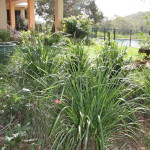 Creek Matt Rush, Lomandra hystrix Creek Matt Rush, Lomandra hystrixIf you want a robust, no fuss clumping plant, Creek Matt Rush Lomandra hystrix is ideal. Growing to 1.5 m. it is usually found along creek beds, and has shiny strap-like leaves, with a weeping habit. Lomandra hystrix has tiny scented flowers in Spring and Summer. |
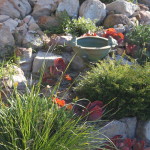 Lomandra confertifolia Lomandra confertifoliaThis Lomandra grows to about 50 cm in height, is relatively hardy, will tolerate full sun, can withstand dry periods, and is not prone to disease or pests. As it grows you can divide the clump and establish new plants. |
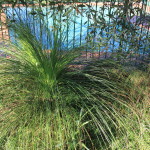 Forest Grass Tree, Xanthorrhoea johnsonii Forest Grass Tree, Xanthorrhoea johnsoniiStarting out as a small clumping plant, the Forest Grasstree makes a stunning feature plant with its dark trunk, dense grassy head of leaves, and a woody flower spike that can grow two to three metres high. |
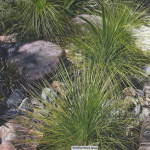 Wallum Grass Tree, Xanthorrhoea fulva Wallum Grass Tree, Xanthorrhoea fulvaThe Wallum Grass Tree is a trunkless, tufting plant that, in its natural habitat, grows in periodically waterlogged sites on sand in coastal areas. |
 Sword Sedge, Gahnia aspera Sword Sedge, Gahnia asperaA clumping plant to 80 cm with razor sharp strappy leaves and distinctive red-brown seeds on flower spikes to 25 cm Gahnia aspera occurs in Wet Eucalypt Forest. It attracts several species of butterfly |
 Frogsmouth, Philydrum lanuginosum Frogsmouth, Philydrum lanuginosumFrogsmouth is suitable for planting around ponds, dams and on creek banks. It will tolerate periodic inundation and can be used as for stablising soil. The lovely yellow flowers are on tall spikes to 60cm most of the year round and the name “Frogsmouth” comes from shape of the flowers. |
 Christmas Bells, Blandfordia grandifolia Christmas Bells, Blandfordia grandifoliaBlandfordia grandiflora is a tufted perennial with narrow, channelled, linear leaves and between two and twenty large, drooping, bell-shaped flowers. The flowers are red with yellow tips, or sometimes entirely yellow. |
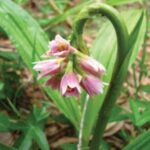 Shepherd’s Crook Orchid, Geodorum densiflorum Shepherd’s Crook Orchid, Geodorum densiflorumGeodorum densiflorum has distinctive pleated leaves, and the pseudobulbs together with the bell shaped flower, make it look like a lily – until you look into tubular bells at the deep pink orchid structure inside. |
Shrubs |
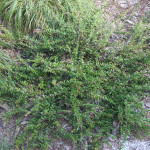 Midyim, Austromyrtus dulcis Midyim, Austromyrtus dulcisMidyim is a scrambling shrub, often prostate, that grows to 1 m. It flowers from spring to autumn and the white flowers are followed by distinctive edible speckled white berries. The new growth has a lovely red tinge, making it a plant that has interest all year round. |
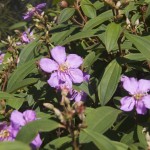 Native Lassiandra, Malastoma malabathricum subsp. malabathricum Native Lassiandra, Malastoma malabathricum subsp. malabathricumNative Lassiandra is a rounded shrub that grows to two metres high with beautiful lilac flowers to five cm across, flowering from Spring to Autumn. It has attractive rough textured leaves, and purple stems, making it an ideal feature plant that can be pruned if required. |
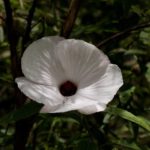 Native Rosella, Hibiscus heterophyllus Native Rosella, Hibiscus heterophyllusNative Rosella is a fast growing shrub up to 6 m high and 2 m wide. It has an open habit with beautiful 10 cm white to pale pink flowers in Spring and early Summer followed by fruit from October to March. |
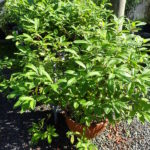 Hairy Psychotria, Psychotria loniceroides Hairy Psychotria, Psychotria loniceroidesHairy Psychotria is an attractive shade loving shrub, 1.5 to 2.5m in height and approx. 1m wide. It has soft downy covered pale green foliage with clusters of white to yellowish small flowers February to April. |
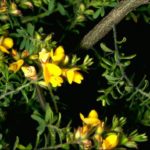 Hairy Bush Pea, Pultenaea villosa Hairy Bush Pea, Pultenaea villosaIn a garden setting, Hairy Bush Pea is a shrub 1-2m that can grow in full or filtered sun. They have yellow/orange pea flowers (sometimes with red markings) from winter to early summer. Pultenaea villosa are known to attract butterflies, bees and small birds. |
 Woolly Aotus, Aotus lanigera Woolly Aotus, Aotus lanigeraWoolly Aotus is a small dense shrub excellent for gardens to about 1.5 m, densely branched close to the ground with stems covered in long, soft usually dark hairs. |
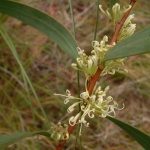 Hakea florulenta Hakea florulentaHakea florulenta is a low growing shrub 1-2m tall. It has clusters of creamy white, pleasantly perfumed flowers in spring, followed by a woody fruit to 25mm. In their natural environment, they often occur under gum trees. |
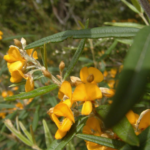 Golden Shaggy Pea, Oxylobium robustum Golden Shaggy Pea, Oxylobium robustumGolden Shaggy Pea is a hardy, fast growing bushy shrub 2-3m in height. It is spectacular when in flower, usually from late winter to spring. |
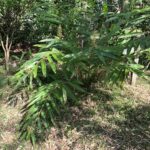 Native Ginger, Alpinia caerulea Native Ginger, Alpinia caeruleaNative ginger has white flower spears to 10cm in spring and summer followed by decorative dark blue fruit. |
Trees |
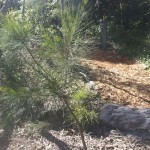 Black She Oak, Allocausarina littoralis Black She Oak, Allocausarina littoralisThe Black She Oak is found in coastal forests and grows to 10m on well-drained sandy soils, which makes it ideal for gardens in Marcus Beach. |
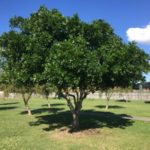 Tuckeroo, Cupaniopsis anacardioides Tuckeroo, Cupaniopsis anacardioidesTuckeroo is a small, attractive, rounded tree to 10m with non-invasive roots that is often used as a feature or street tree. It is very hardy, tolerating both frost and drought once established. |
 Quinine Berry, Petalostigma triloculare Quinine Berry, Petalostigma triloculareQuinine berry is a shrub 3-5m with greyish trunk and dense oval shaped glossy dark green leaves. It has small green to cream flowers, summer to autumn. The fruit is orange or reddish to 10mm, with a bitter taste. |
 Native Hydrangea, Abrophyllum ornans Native Hydrangea, Abrophyllum ornansNative Hydrangea has large striking leaves with small teeth, often on the upper half of leaves. Native Hydrangea has small fragrant flowers from November to December followed by purple to black berries approx. 5mm in diameter ripening between March and October. |
 Macaranga, Macaranga tanarius Macaranga, Macaranga tanariusThis common, very fast-growing small tree can grow to 6m and approx. 4m wide. A flush of creamish-yellow flowers from spring to summer followed by green fruit capsules with black fruit attract birds such as Silvereyes and Rosellas. |
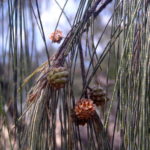 Horse-tail She-oak, Casuarina equisetifolia Horse-tail She-oak, Casuarina equisetifoliaThis graceful drooping tree grows 6-8 metres and “sings” in the breeze. It produces reddish brown flowers (male and female flowers on the same tree) in March-May, followed by bird attracting seed pods. |
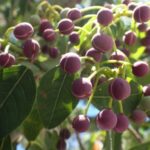 Bleeding heart tree, Homolanthus nutans Bleeding heart tree, Homolanthus nutansHomalanthus nutans is a lovely small tree to 6m with an attractive spreading canopy up to 4m. In its natural habitat, along forest edges, it is known as a pioneer plant because it grows fast and protects slower growing species. |
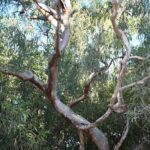 Tumbledown Gum, Eucalyptus bancroftii Tumbledown Gum, Eucalyptus bancroftiiSmall tree that grows to 10m tall. The attractive crooked twisted trunk, and contorted branches have bark that peels away in bright orange patches gradually becoming grey/brown. |
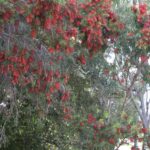 Weeping Bottlebrush, Melaleuca viminalis Weeping Bottlebrush, Melaleuca viminalisA large shrub or small tree that grows up to 10m, Melaleuca viminalis creates a stunning splash of colour in spring and provides nectar for insects and birds. It is the ideal small feature tree if you wish to incorporate a vertical element in your garden design. |
Palms, Ferns and Cordylines |
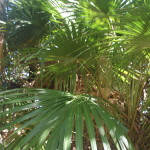 Cabbage Palm, Livistona australis Cabbage Palm, Livistona australisA very slow growing single trunked palm eventually growing to 20-30 m. Cabbage Palms grow in the rainforest, wallum woodland and wet eucalypt forest. The leaves have segments that join at the base giving them their round fan-like appearance. |
 Birds Nest Fern Asplenium australasicum Birds Nest Fern Asplenium australasicumA very reliable, easily cultivated fern, the Birds Nest Fern prefers moisture, but can tolerate dry spells. The rosette of radiating fronds grows to 1.5 metres in optimum conditions. |
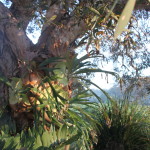 Elkhorn Fern, Platycerium bifurcatum Elkhorn Fern, Platycerium bifurcatumThe Elkhorn Fern is an epiphyte that grows on the trunks and branches of trees. It consists of a series of plantlets that have fronds of 25-90 cm. protruding from the base nest leaf. This nest leaf that is 12-30 cm wide attaches itself to the tree. |
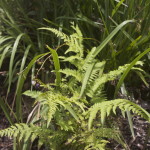 Binung Fern, Christella dentata Binung Fern, Christella dentataThis soft, tufting fern with fronds from 50 cm to 1 m, grows well in partly shaded, sheltered areas. Its natural habitat is on creek banks and swampy areas so it requires moist conditions to flourish. |
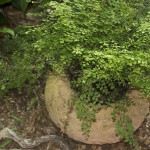 Maiden Hair Fern, Adiantum atrovirade Maiden Hair Fern, Adiantum atroviradeWith its soft, lacy foliage and black glossy stems, Maiden Hair Fern makes a beautiful feature plant in a decorative pot. |
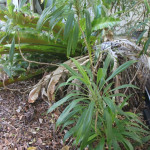 Palm Lily, Cordyline, Cordyline petiolaris Palm Lily, Cordyline, Cordyline petiolarisCordyline petiolaris is a palm-like, upright rainforest plant that grows to 5 m. It has broad leaves, 80-120 cm long by 15 cm wide, small white flowers in Autumn and attractive red berry clusters in Summer. |
 Binung, Christella dentata Binung, Christella dentataAn attractive, hardy fern to 1m. In nature they grow along rainforest creeks banks or in wetland areas. They prefer shaded or partly shaded sites making them ideal for under decks or as an indoor pot plant. |
